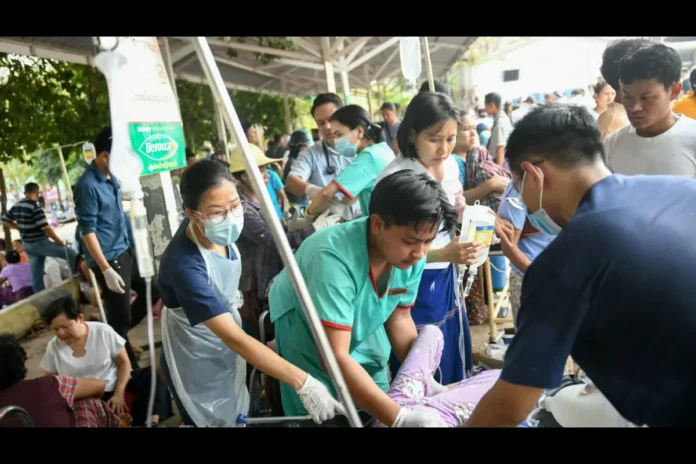A powerful 7.7-magnitude earthquake struck Myanmar on Friday, causing buildings to collapse and leaving many feared dead.
Thai authorities declared Bangkok an “emergency zone” as tremors spread across the region. The quake disrupted daily life, forcing people to flee buildings and seek shelter.
The earthquake affected a vast part of Southeast Asia, shaking war-torn villages in Myanmar and towering skyscrapers in Bangkok. Even China’s Yunnan province, known for its mountainous terrain, felt the tremors. The widespread impact of the quake underscored the severity of the disaster, leaving many in shock.
Witnesses described the earthquake as an unstoppable force of nature. Erik Jonan, a US citizen visiting Pattaya, Thailand, compared it to “Mother Nature swatting a fly.” His words reflected the fear and helplessness people felt as buildings swayed and debris filled the air.
Rescue teams are now working tirelessly to assist affected communities, but the response varies by country. Myanmar, one of Asia’s poorest nations, has historically struggled with disaster response. Meanwhile, Thailand, with its better resources, mobilized experienced rescue teams to aid those trapped under debris.
Videos posted online captured the terror as people fled buildings in Myanmar and Thailand. Dust filled the air while traffic came to a sudden stop. The immediate chaos highlighted the quake’s devastating force and the region’s vulnerability to natural disasters.
Myanmar’s military junta declared an emergency across central regions, including Mandalay and Naypyidaw. Officials confirmed multiple fatalities and urged citizens to donate blood. Hospitals struggled to accommodate victims as emergency response efforts began. Rescue teams raced to pull survivors from collapsed buildings.
Thailand’s prime minister declared Bangkok an “emergency zone” after an under-construction high-rise collapsed near Chatuchak Park. The disaster killed at least three people, according to Defense Minister Phumtham Wechachai. Authorities warned residents to remain cautious as damage assessments continued.
Jack Brown, a longtime Bangkok resident, witnessed the collapse of the high-rise while taking shelter in his car. “If anyone was inside, there would be fatalities,” he told the media. His account illustrated the widespread fear and uncertainty caused by the quake.
Rescue teams are working to free 81 people trapped beneath the rubble, according to Thai officials. Bangkok’s governor urged residents to stay vigilant, as many high-rise buildings suffered structural damage. Authorities confirmed two additional deaths in the capital, intensifying concerns over safety.
Myanmar continues to grapple with civil war, further complicating relief efforts. The ongoing conflict has weakened its health infrastructure, making disaster response even more difficult. The earthquake adds another layer of suffering to a nation already in crisis.
Large portions of Myanmar remain under rebel control, making it difficult to gather reliable information. A complex network of ethnic militias and armed groups governs these regions. The lack of centralized authority hampers efforts to assess damage and coordinate relief operations.
Mandalay residents described their terrifying experience during the quake. “It was so powerful that we couldn’t run outside immediately,” said Tun Kyaw, 26. He and others hid under desks for safety. Many feared their buildings would collapse before they could escape.
Christina Powell from the United Nations Office for the Coordination of Humanitarian Affairs emphasized the need for immediate aid. “We are assessing the impact and gathering data to guide our response,” she stated. More updates will follow as relief teams mobilize.
The earthquake struck near Mandalay at 12:50 p.m. local time. The historic city, home to 1.5 million people, houses ancient temples and palaces. The United States Geological Survey reported multiple aftershocks, including one measuring 6.4 in magnitude.
The epicenter was in Myanmar’s Sagaing region, a war-torn area controlled by multiple factions. Travel remains difficult due to numerous military and rebel checkpoints. Limited infrastructure and ongoing violence further obstruct relief efforts, leaving many stranded without assistance.
Sagaing’s rural communities, composed mainly of wooden houses, suffered extensive damage. Communication remains unstable due to intermittent conflict. Authorities struggle to determine the full extent of destruction, but initial reports indicate widespread devastation and displacement.
In Taungoo, a town 70 miles south of Naypyidaw, a mosque partially collapsed, killing three people. Rescue efforts are underway as authorities search for survivors. The disaster compounds existing challenges in a region already suffering from political instability.
Residents of Yangon, Myanmar’s commercial hub, described their experience. “The quake lasted about a minute, and we ran outside immediately,” one resident said. Another noted that phone networks temporarily went down but have since been restored.
A Yangon resident named Wang, who was on the 20th floor of a building, recalled the panic. “Everyone around me was terrified,” Wang said. “The shaking was intense and lasted a long time.” Many feared for their lives as the city swayed around them.
Footage from Myanmar showed a road bridge over the Irrawaddy River collapsing. The structure crumbled into the water, creating a massive cloud of dust. The video underscored the widespread destruction caused by the earthquake.
In Chiang Mai, Thailand, residents also felt the tremors. “I couldn’t stay inside, so I ran into the street,” one individual shared. People across the region experienced similar panic as buildings shook and uncertainty loomed over them.
Bangkok’s Suvarnabhumi Airport remained operational two hours after the quake, authorities confirmed. Flights continued as scheduled, providing relief to travelers concerned about disruptions. The transportation sector managed to withstand the disaster without major interruptions.
By Friday evening, Thailand’s Prime Minister Paetongtarn Shinawatra reassured the public that the situation was stabilizing. “The worst has passed,” he announced. Although 12 aftershocks were recorded, no tsunami threat emerged, as the epicenter lay far inland.


